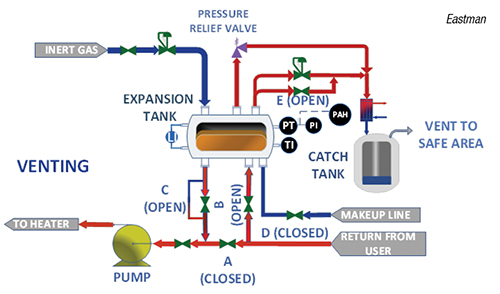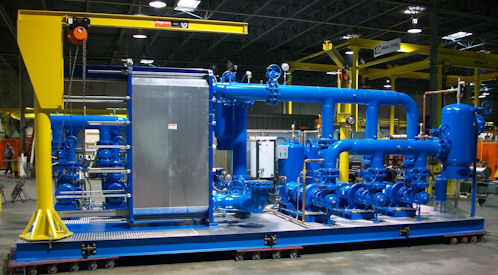The Duty of Heat Transfer Solutions in Sustainable Energy Solutions for the Future
Heat transfer systems are important in the mission for sustainable energy options. They optimize thermal energy management, boosting the efficiency of sustainable technologies. By utilizing systems like convection, conduction, and radiation, these systems minimize power losses. Their role in solar thermal and geothermal applications is especially substantial. As advancements emerge, the capacity for additional innovations raises crucial inquiries about future power techniques. What developments will form the landscape of lasting power?
Understanding Heat Transfer Systems

The Relevance of Thermal Energy Monitoring
Efficient thermal energy management is vital for taking full advantage of power efficiency and minimizing waste in different systems. By regulating temperature and enhancing Heat transfer procedures, companies can significantly decrease energy consumption and operational expenses. Reliable management involves the implementation of sophisticated modern technologies and techniques that keep track of and control thermal conditions within systems, guaranteeing that power resources are used successfully. Additionally, proper thermal energy management adds to decreasing greenhouse gas emissions, straightening with worldwide sustainability goals. It likewise improves system reliability and efficiency, resulting in boosted item top quality and longer tools life expectancy. Inevitably, focusing on thermal energy management is an important action in the direction of creating a lot more sustainable energy services and promoting a liable method to energy usage in industrial and property contexts.
Applications of Heat Transfer in Renewable Resource
While various renewable energy resources promise sustainability, the effective application of Heat transfer plays a vital function in their efficiency. In wind power systems, Heat transfer is used for wind turbine element air conditioning, boosting efficiency and durability. Geothermal energy relies upon reliable Heat exchange between the planet's subsurface and the liquid flowing in the system, taking full advantage of power removal. Biomass power procedures likewise take advantage of Heat transfer, as it helps in transforming natural materials right into useful fuel through pyrolysis and gasification. In addition, in hydropower, preserving suitable temperature levels in reservoirs can improve power output. Each of these applications demonstrates the crucial importance of Heat transfer systems in boosting eco-friendly power modern technologies, inevitably adding to a more sustainable power future.
Enhancing Solar Thermal Power Performance
As solar thermal power systems proceed to advance, enhancing their effectiveness has come to be important for making the most of power result. Advances in Heat transfer modern technologies, such as improved thermal storage space products and cutting-edge Heat exchangers, play a substantial role in improving performance. By making use of advanced materials that have superior thermal conductivity, systems can record and move Heat a lot more effectively. Additionally, incorporating monitoring systems that adhere to the sunlight's path guarantees that enthusiasts get ideal solar exposure throughout the day. Utilizing nanotechnology in solar absorbers can better increase power absorption prices. Moreover, incorporating computerized control systems helps handle and control temperatures energy circulation efficiently, resulting in lowered losses and enhanced general system effectiveness. These enhancements lead the means for more lasting solar thermal energy remedies in the future.
Geothermal Heating: A Sustainable Solution
Geothermal home heating presents a practical choice for sustainable power, supplying significant ecological benefits with decreased greenhouse gas discharges. Its efficiency and cost-effectiveness make it an attractive choice to traditional home heating systems. Obstacles associated to application must be resolved to maximize its prospective influence.
Environmental Benefits of Geothermal
Traditional heating techniques add significantly to greenhouse gas discharges, geothermal heating provides a compelling alternative that lessens environmental impact. By taking advantage of the Earth's interior Heat, geothermal systems utilize a renewable resource source, noticeably reducing dependence on fossil gas. This method creates very little carbon emissions, making it a cleaner alternative for property and industrial home heating. In addition, geothermal systems advertise power performance, as they call for much less power contrasted to standard furnace. DVS Heat Transfer Systems. The usage of geothermal energy likewise helps in lowering air contamination, enhancing regional air high quality and public wellness. As a sustainable remedy, geothermal heating sustains environment change reduction efforts, positioning itself as a vital element in the change in the direction of a greener future
Effectiveness and Cost-Effectiveness
How does geothermal heating gauge up in terms of efficiency and cost-effectiveness contrasted to typical heater? Geothermal home heating demonstrates exceptional efficiency, commonly attaining a coefficient of performance (COP) of 3 to 5, implying it creates 3 to 5 units of Heat for every single unit of electrical power consumed. This performance converts right into lower operating expense, particularly in areas with stable geothermal sources. Preliminary installation costs can be greater than traditional systems; nevertheless, lasting financial savings on energy bills and lowered maintenance expenditures can counter these in advance financial investments. Furthermore, many federal governments incentivize geothermal systems via rebates and tax credit histories, improving their cost-effectiveness. On the whole, geothermal heating arises as a sustainable and economically feasible alternative to more standard heating solutions.
Implementation Difficulties and Solutions
Countless challenges can hamper the extensive implementation of geothermal furnace, despite their clear benefits as a lasting energy option. High preliminary setup prices often prevent home owners and investors, making funding a significant barrier. Additionally, the geographical restrictions of suitable geothermal sites limit ease of access in particular areas. Neighborhood policies and permitting procedures can additionally make complex task growth, bring about delays. Additionally, public recognition and understanding of geothermal systems stay reduced, preventing acceptance. To resolve these challenges, targeted education projects can enhance public expertise, while government rewards could ease financial burdens. Teaming up with local authorities to improve policies may promote smoother job approvals, eventually promoting the adoption of geothermal home from this source heating as a sensible, sustainable power option.
Advancements in Heat Transfer Technologies
Technologies in Heat transfer technologies play a crucial function in boosting power effectiveness and sustainability. Advanced Heat exchangers and phase adjustment products go to the leading edge of these advancements, offering considerable renovations in thermal management. These modern technologies not just optimize power use but also add to minimizing ecological influence in numerous applications.
Advanced Heat Exchangers
Advanced Heat exchangers play a crucial role in improving energy effectiveness across numerous applications in lasting energy remedies. These devices facilitate the transfer of Heat between 2 or even more fluids, substantially reducing energy usage in procedures such as industrial home heating, cooling, and power generation. Developments in products and layout, such as the usage of nanofluids and portable arrangements, have actually resulted in improved thermal performance and minimized dimension requirements. Additionally, improvements in digital surveillance and control systems enable for optimized procedure, further boosting performance. By lessening waste Heat and maximizing power healing, progressed Heat exchangers add to reduce carbon footprints and support the shift toward ecologically friendly technologies. Their continued development is important for attaining international energy sustainability objectives.
Stage Modification Products
The assimilation of phase modification products (PCMs) into Heat transfer modern technologies represents a substantial advancement in energy management and effectiveness. PCMs take in and release thermal power during their stage adjustments, enabling efficient temperature level regulation in structure products and power systems. By keeping excess check my source Heat throughout top periods and launching it when demand increases, PCMs add to load moving and energy conservation - DVS Heat Transfer Systems. This capability boosts the efficiency of renewable resource systems, specifically in solar thermal applications. In addition, PCMs can improve the thermal convenience of indoor atmospheres, reducing dependence on traditional home heating and cooling approaches. As advancements in PCM formulas remain to arise, their duty in sustainable power solutions is positioned to grow, using appealing avenues for future research and application

Future Prospects for Heat Transfer in Lasting Power
As the demand for sustainable energy remedies remains to climb, the function of Heat transfer systems is coming to be progressively essential fit future innovations. Technologies in layouts and products are expected to enhance effectiveness in Heat transfer, lowering energy losses in various applications. The combination of advanced thermal storage systems, such as stage adjustment products and thermochemical storage, will enable far better management of energy sources. Research into nanofluids and biomimetic Heat exchangers might even more enhance thermal efficiency. Moreover, the adoption of wise innovations will permit real-time tracking and flexible control of Heat transfer procedures. These developments are poised to greatly add to the overall performance and sustainability of power systems, leading the way for an extra energy-efficient future.
Regularly Asked Inquiries
How Can People Apply Heat Transfer Solution in your home?

Individuals can execute Heat transfer systems in your home by mounting energy-efficient home appliances, making use of glowing heating, and optimizing insulation. These procedures enhance energy effectiveness, lower costs, and advertise sustainable practices in residential settings.

What Are the Expenses Connected With Mounting Heat Transfer Equipments?
The expenses related to installing Heat transfer systems differ widely, generally encompassing tools, setup labor, and maintenance. Factors such as system type, home size, and regional laws substantially influence the general expenditure entailed.
Are There Government Incentives for Heat Transfer System Installations?
Government motivations for Heat transfer system installments Recommended Site vary by area and can consist of tax obligation credit histories, refunds, and grants. These financial benefits aim to encourage adoption, eventually promoting power efficiency and minimizing ecological influence within areas.
Exactly How Do Heat Transfer Equipments Impact Power Bills?
Heat transfer systems notably affect power bills by optimizing energy performance. By enhancing the transfer of Heat, these systems decrease power intake, causing lower energy expenses and producing an extra sustainable technique to energy monitoring.
What Maintenance Is Needed for Heat Transfer Solutions?
Upkeep for Heat transfer systems includes routine assessments, cleansing of components, examining fluid degrees, making sure appropriate insulation, and changing worn components. These tasks assist maintain efficiency, protect against break downs, and extend the system's operational life expectancy.
These systems facilitate the activity of thermal energy from one medium to an additional, enabling the transfer of Heat for energy, home heating, or air conditioning generation purposes. Geothermal energy relies on effective Heat exchange in between the earth's subsurface and the fluid flowing in the system, optimizing energy removal. Furthermore, geothermal systems promote energy efficiency, as they require less energy compared to standard home heating systems. Advanced Heat exchangers play an essential duty in improving energy effectiveness across various applications in sustainable power remedies. Heat transfer systems especially affect power bills by optimizing power performance.